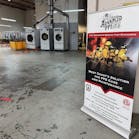Challenges Facing Nation's Fire Service Addressed at Summit
Source Firehouse.com News
Editor's Note: This story will be updated throughout the day.
EMMITSBURG, MD – President Joe Biden is expected to address the U.S. Fire Administrator's Summit on Fire Prevention and Control virtually Tuesday afternoon.
Hundreds of fire and rescue personnel from across the country are at the National Fire Academy -- not to fight a fire but to address issues that threaten the lives of responders.
Unlike last year's invitation-only summit, this one is open to everyone.
Homeland Security Director Alejandro Mayorkas praised the firefighters for their efforts. "Thank you for your extraordinary service."
He added that he knows that responding to structural fires are just about five percent of what they do. Regardless of the nature of the call -- wrecks, floods, emergency medical issues -- Mayorkas lauded firefighters for their willingness to help.
"Firefighters are the first to be called and the last to leave."
FEMA Administrator Deanne Criswell said the country has experienced an unprecedented time with the record devastating wildfire in Maui to hurricanes.
Responding to the horrific incidents takes its toll and she promised to work together to 'shore up the firefighting community...
Firefighter mental health and well-beingAn increasing number of firefighters die by suicide, experiencing mental health issues such as post-traumatic stress, contracted from exposures they suffered while delivering emergency services to the public.
It’s estimated that at least 100 firefighters die by suicide annually.
“We need to provide mental health and wellness resources and suicide prevention initiatives for all firefighters,” according to U.S. Fire Administration (USFA) officials.
The U.S. Fire Administration also needs to have a model similar to the Law Enforcement Suicide Data Collection, launched by the FBI on Jan. 1, 2022.
Codes & standards
In buildings with automatic sprinklers, the civilian fire death rate is 89 percent lower than in non-sprinklered buildings and the injury rate is 27 percent lower.
Providing federal funding to local jurisdictions for code enforcement, inspection and implementation will increase fire and life safety in the communities especially in the wildland-urban interface areas.
Nearly three out of five home fire deaths are caused by fires in properties without smoke alarms or ones that failed.
Firefighter cancer
Firefighters have a nine percent higher risk of developing cancer and 14 percent higher risk of dying from cancer compared to the general public.
A firefighter’s occupational exposure is at the highest level – Class 1 – according to the World Health Organization’s International Agency for Research on Cancer.
The USFA believes revised screening guidelines can help medical professionals and insurance companies understand the need to screen firefighters based on their higher cancer risk.
The National Firefighter Registry is “a critical pathway to addressing cancer risk and all firefighters are encouraged to register.
Fire service recruitment & retention
In recent years, there has been a steady decline in the number of firefighters in the nation.
Increasing call volumes, time demands, increased training requirements are among the reasons for the reduction in volunteers.
“It is imperative that we invest in programs and initiatives to incentivize individuals to join volunteer, combination and career fire departments,” USFA officials say.
Impact of climate change
The intensity of wildfires has increased as has the number of wildfires impacting the built environment over the past 30 years.
A recent National Fire Protection Association (NFPA) needs assessment found that “while 87 percent of structural fire departments respond to interface fires, just under half have training.”
The USFA’s goal is to ‘prepare all firefighters for the climate-driven increase in wildland-urban interface (WUI) and in rural and suburban communities by providing them with the proper training and equipment.”
EV and energy transition
The USFA believes it’s vital that firefighters understand the dangers associated with lithium-ion (LI) batteries.
Officials noted that research shows the LI batteries present four hazards to firefighters – flammable gas release, flaming, vented deflagrations and explosions.
“The fire service must lead the discussion of safety surrounding the LI batteries and other alternative energy sources.”

Susan Nicol | News Editor
Susan Nicol is the news editor for Firehouse.com. She is a life member and active with the Brunswick Volunteer Ambulance & Rescue Company, Oxford Fire Company and Brunswick Vol. Fire Co. Susie has been an EMT in Maryland since 1976. Susie is vice-president of the Frederick County Fire/Rescue Museum. She is on the executive committee of Frederick County Volunteer Fire and Rescue Association. She also is part of the Maryland Institute for Emergency Medical Services Systems (MIEMSS) Region II EMS Council. Susie is a board member of the American Trauma Society, Maryland Division. Prior to joining the Firehouse team, she was a staff writer for The Frederick News-Post, covering fire, law enforcement, court and legislative issues.






